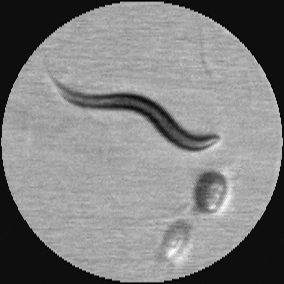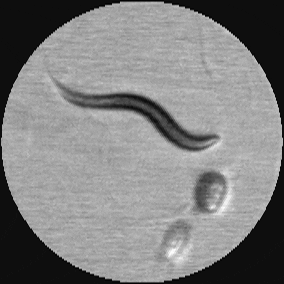
Israel develops rapid imaging technology reconstructing images of tiny roundworm without using camera
The complicated movement of a tiny, slithery nematode worm or roundworm (C. elegans) – which are among the most abundant animals on Earth has been reconstructed by researchers at the Technion-Israel Institute of Technology in Haifa using an innovative rapid imaging technology. Published in Nature Communications, the development project was headed by Professor Amir Rosenthal, doctoral student Evgeny Hahamovich, and master’s student Sagi Monin of the Andrew and Erna Viterbi Faculty of Electrical and Computer Engineering.

The research team’s technology is based on the innovative SPI (single-pixel imaging) concept – the production of high-quality images using a device equipped with only a single detector. The technique, which enables photographs to be taken without a camera, has vast potential for diverse applications, such as the development of components of warning systems in autonomous vehicles or enhanced image depth in microscopy of biological tissues.
SPI is based on the illumination of an object with encoded light patterns, generally by means of a projector. Based on the properties of the light reflected and propagated by the object, the image of the object can be produced using reconstruction algorithms. The problem is that to date, these systems have been hampered by significant limitations, one of them being the slow image acquisition rate, which is the result of the fact that the projectors themselves are slow. This has, until now, limited use of the systems to photographing objects that do not move. .
Nematodes move a lot. They are parasites in animals and plants or as free-living forms in soil, fresh water, marine environments, and even such unusual places as vinegar, beer malts and water-filled cracks deep within Earth’s crust. A great deal of research has been conducted on the parasitic forms because most of them have some medical, veterinary or economic importance.
Before the Haifa researchers’ achievement, it would have been impossible to create an image of a moving object using the SPI technology that is currently available.
Published in the prestigious Nature Communications under the title “Single pixel imaging at megahertz switching rates via cyclic Hadamard masks,” the development was achieved by the development project was headed by Prof. Amir Rosenthal, doctoral student Evgeny Hahamovich, and master’s student Sagi Monin of the Technion’s Viterbi Faculty of Electrical and Computer Engineering.
SPI is based on the illumination of an object with encoded light patterns, generally by means of a projector. Based on the properties of the light reflected and propagated by the object, the image of the object can be produced using reconstruction algorithms. The problem is that to date, these systems have been hampered by significant limitations, one of them being the slow image acquisition rate, which is the result of the fact that the projectors themselves are slow, so the systems have been used only to photograph stationary objects.
The Technion research team broke through this limitation by applying a new method for spatially encoding light at unprecedented frequencies – 2.4 MHz as opposed to 22 kHz, which is the maximum frequency currently available in SPI technology. This represents an improvement of more than a hundredfold in projection rates and image acquisition rates. By using a rotating device fitted with a coding mask, the researchers created a completely new illumination pattern and an SPI microscope with unprecedented capabilities.
To demonstrate the system’s capabilities, the research group produced videos with a frame rate of 72frames per second. The films accurately depict the movement of the nematode worm.
Optical imaging is commonly performed with either a camera and wide-field illumination or with a single detector and a scanning collimated beam; unfortunately, these options do not exist at all wavelengths. Single-pixel imaging offers an alternative that can be performed with a single detector and wide-field illumination, potentially enabling imaging applications in which the detection and illumination technologies are immature.
However, single-pixel imaging currently suffers from low imaging rates owing to its reliance on configurable spatial light modulators, generally limited to 22 kHz rates.
Digital cameras are one of the most widely used tools in optical imaging today. From mobile phones to advanced microscopy techniques, camera technologies, such as charge-couple devices (CCD) and metal-oxide-semiconductor (CMOS), have revolutionized the world of imaging. Yet, in many applications, digital cameras are not an option. Mature camera technology is available only in a small portion of the electromagnetic spectrum, and its performance characteristics may limit some applications.
The new method for ultra-fast SPI achieves rates up to 2.4 million pixels per second achieved without compressed-sensing algorithms, they explained. Further increase in the imaging rate may be achieved by using compressed-sensing algorithms but at the expense of potentially slower image reconstruction. To fully exploit the benefits of compressed-sensing theory, they concluded, it may be beneficial to replace the well-conditioned basis used in this work with a new type of cyclic, or semi-cyclic, basis in which the incoherence is optimized.
Israel in the News